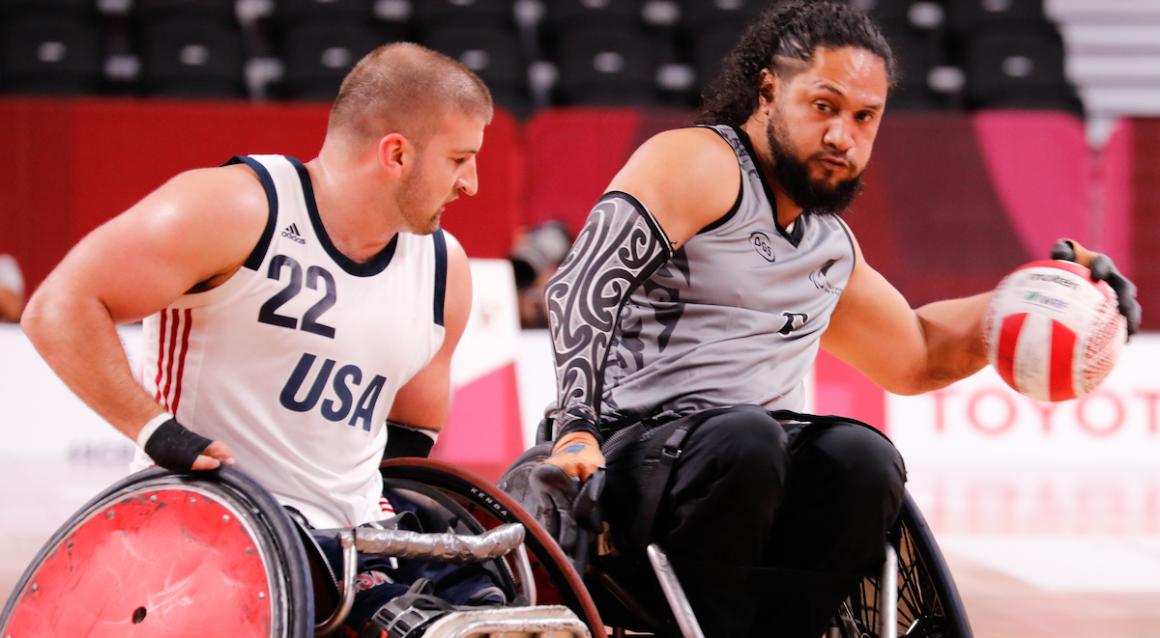
The Power of the Paralympics
Two-time Paralympic medal winner Kelly Crowley ’99 believes sports fans who enjoyed the recent Tokyo 2020 Summer Olympics will find the Tokyo 2020 Paralympic Games that kick off this week just as compelling.
“It’s elite sport and good competition,” says the Santa Clara University alumna who took home two gold medals in swimming at the 2004 Athens Paralympic Games and two bronze medals in cycling from the 2012 London Paralympic Games.
“The core of what Paralympians do is the same as Olympians in that we hope that we have honed a craft and a set of physical skills to be experts—not in comparison to the able-bodied world, but just inherently for who we are,” Crowley says.
For her and many others, that is the power of the Paralympics: not only does it give the athletes opportunities to reframe and redefine what is disability, but what is inclusion, and what is access.
“It’s a conversation starter,” she says, “because most people love sports.”
The Tokyo Paralympic Games, from Aug. 24 to Sept. 5, feature a record 4,403 athletes with physical disabilities, from 162 nations, competing in 22 sports.
The first-ever primetime broadcast of the games on NBC Universal also will feature a record 1,200 hours of programming, including more than 200 hours of television coverage across NBC, NBCSN and the Olympic Channel: Home of Team USA.
Crowley, who works in the Bay Area as a user experience researcher for Visa’s accessibility team, had tickets to attend the Tokyo Paralympic Games with her husband—they were even learning Japanese in anticipation of the trip. But like the recent Olympics, fans have been banned because COVID-19 cases are surging, so they will watch the athletes—including 240 representing Team USA—on TV.
We talked to Crowley about how the Paralympic Games are evolving, the continued challenges, and who she’s going to be watching in the upcoming competitions.
Coinciding with the Tokyo Paralympics, the International Paralympic Committee on Aug. 19 launched a decade-long anti-discrimination campaign called WeThe15, with global landmarks—from New York’s Empire State Building to Rome’s Coliseum to the London Eye—lit up in purple to support the 1.2 billion people in the world with a disability. Why is this an important campaign?
As a society, we define disability as meaning ‘I can’t’ or ‘You can’t’ or ‘You are excluded.’ We have actually constructed a society that makes people with a disability invisible. And at the same time, we are all going to experience disability at some point in our lives. The campaign is trying to help people understand that disability is everywhere—it’s 15 percent of the world’s population. When you combine them with their family and close friends who make spending decisions based on the needs and requirements of their loved ones, you’re talking about more than three billion people with a spending power of almost or slightly more than $10 trillion. That is a massive market, and people are starting to take notice.
In what ways have the Paralympics evolved since you were competing?
Probably the biggest change occurred in 2018 when the U.S. Olympic Committee agreed to give Paralympians equitable medal money. Historically, there was a huge gulf between what Olympians and Paralympians got; there’s an actual bonus that athletes get paid when they win medals. According to the New York Times, Paralympians were paid $7,500 for gold, $5,250 for silver, and $3,750 for bronze. Today those sums match Olympians’ $37,500 for gold, $22,500 for silver and $15,000 for bronze.
It’s a huge deal, and I would love for that to be retroactive, because it’s not a trivial amount! It can be life-changing if you’re competing in multiple events.
The USOC also agreed to change its name to the U.S. Olympic & Paralympic Committee. And last year, a new U.S. Olympic & and Paralympic Museum opened in Colorado Springs. I was there before they had all the exhibits built, before COVID-19, and it was breathtaking to walk through those accessible spaces. It has 12 galleries, and lots of interactive exhibits. You get an RFID tag in one area where the content depends on what you set your preferences to. So if my family goes there, they can say, “I’m interested in Kelly Crowley,” and they could see me in the museum. It democratizes the telling of history and the museum experience.
Lack of money and resources for Olympic sports training is well-known—especially on top of the COVID-19 restrictions. But what about the custom-made equipment many para-athletes must buy in order to compete?
A lot of the journey of elite para-athletes is pretty much the same as the Olympians, in terms of finding a sport you have some talent for, and training really hard. It’s their everyday job, and for a lot of them, it’s their profession and they don’t get paid, so they have sponsors and jobs on the side to make it work. But when you think about all the resources it takes to overcome all the obstacles of being someone with a disability, they are magnified for an elite para-athlete. It’s part of the package. The equipment has to be light and functional and it has to fit you perfectly.
I have this funny little arm, and my elbow doesn’t bend, and I have three fingers on my right hand. So when I raced in road races, I would lose time when I had to shift gears on my bike and take my hand out of one position and move it on my handlebar to another position. Finally, a sponsor got me electronic shifting, and that helped me change my race results. But it was expensive — more than $1,000. And that doesn’t even include my custom handlebar, and I had sponsors chip in for that.
When you think about a young kid who is seven or eight and potentially wanting to run in track and field events and they are a leg amputee, their parents have to purchase the special running leg themselves, because insurance typically allows only one (sports) prosthetic in your lifetime. And that’s not fair to a kid who has no recourse. Luckily, there are organizations like Challenged Athletes Foundation that raise millions of dollars every year to give out to kids and their families for custom equipment, and the technology that goes into it.
How did para-athletes handle the stress of training during COVID-19?
For many para-athletes I know, it’s been a difficult and challenging environment, a roller-coaster ride, with ups and downs. And it has exacerbated the inequities in training; racial inequalities that exist are just magnified in the disability community. If you live in a wealthy community and you have a neighbor who has a lap pool, then you continue to train. But if you were relying on being able to access a public pool, it may not have been open. That kind of stress is not good for elite performance. So you have to be a pretty good stress manager at this point in order to compete well.
That said, there was no guarantee that the Olympics were going to go smoothly. So the fact that the Paralympics are even happening is a testament to teamwork, to resilience, and to strength—and those are all things that Paralympians have in spades.
Can you talk about some of the events and athletes you’re especially excited about watching?
I highly recommend watching our U.S. men's and women's wheelchair basketball programs; the same thing with wheelchair rugby. It’s fantastic.
In wheelchair tennis, keep an eye out for Dylan Alcott from Australia, and for Japanese wheelchair player Shingo Kunieda.
The U.S. women’s sitting volleyball program is a gold medal favorite, and Katie Holloway is my personal favorite, because we host a podcast together called insideparasport.
I am definitely looking forward to watching U.S. long jumper Lex Gillette—that man can literally fly. I’m betting on American Daniel Romanchuk, who is the reigning men’s wheelchair world champion in the 800 and the marathon; he’ll probably win everything. And in swimming, two of my U.S. teammates from Athens, who were younger, are still competing and are five-time Paralympians: Jessica Long and Rudy Garcia-Tolson. I recommend watching everything in swimming!
American Brad Snyder is racing in the paratriathlon, with a former triathlete Olympian as his guide, Greg Billington, so he’s fighting for Brad, which is really cool. Then, our women’s paratriathlete program is super strong with Allysa Seeley and Melissa Stockwell.
Badminton is new at the Tokyo Paralympics this year, and it’s on my list to watch. They’re so fast, with cat-like reflexes; it’s a really exciting sport! I also recommend boccia—it’s for all those curling fans out there. You’ll want to check it out.

